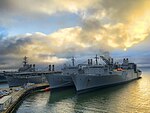Alameda Terminal

Alameda Terminal (also known as Alameda Wharf) was a railroad station and ferry wharf at the foot and west of present-day Pacific Avenue and Main Street in Alameda, California, on the eastern shore of San Francisco Bay with ferry service to San Francisco.: 10–11 It was built in 1864 and operated by the San Francisco and Alameda Railroad. In 1869, it served as the original west coast terminus of the U.S. First transcontinental railroad,: 7 until the opening of Oakland Pier two months later. The western terminus was inaugurated September 6, 1869, when the first Western Pacific through train from Sacramento reached the shores of San Francisco Bay at Alameda Terminal, — thus completing the first transcontinental railroad "from the Missouri river to the Pacific ocean" in accordance with the Pacific Railroad Acts.
Excerpt from the Wikipedia article Alameda Terminal (License: CC BY-SA 3.0, Authors, Images).Alameda Terminal
Pier 2, Alameda
Geographical coordinates (GPS) Address Nearby Places Show on map
Geographical coordinates (GPS)
| Latitude | Longitude |
|---|---|
| N 37.775777 ° | E -122.304766 ° |
Address
Pier 2
94607 Alameda
California, United States
Open on Google Maps







